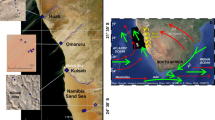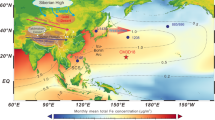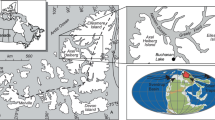Abstract
Pettersson and Rotschi1 have suggested that cosmic dust may be in part the source of the nickel found in Pacific deep-sea cores. In these cores nickel occurs in amounts up to 0.08 per cent, and it was stressed that this is considerably higher than the average value of 0.008 per cent given by Sandell and Goldich2 for the uppermost crust of the earth. Öpik3 concurred with the view that the nickel is largely of cosmic origin, and concluded that the “zodiacal light as interpreted by van de Hulst4, and the cosmic nickel revealed by the Swedish Deep-Sea Expedition are produced mainly by primordial dust of the solar system spiralling towards the sun in orbits which are nearly circular”. Buddhue5 estimated from the amounts of cosmic dust brought down by rain that the annual fall of magnetic particles over the earth's surface is 35–70 × 106 kgm., while Norris and Hogg6, from the weight of magnetic particles falling on trays exposed in north-west Canada, state that the annual fall per square kilometre amounts to less than half a kilogram. Support3 for a cosmic origin of nickel was also given by the similarity between van de Hulst's figure for the space density of the zodiacal light cloud of primordial dust and that required to account for the nickel content of deep-sea clays.
This is a preview of subscription content, access via your institution
Access options
Subscribe to this journal
Receive 51 print issues and online access
$199.00 per year
only $3.90 per issue
Buy this article
- Purchase on Springer Link
- Instant access to full article PDF
Prices may be subject to local taxes which are calculated during checkout
Similar content being viewed by others
References
Pettersson, H., and Rotschi, H., Geochim. et Cosmochim. Acta, 2, 81 (1952).
Sandell, E. B., and Goldich, S. S., J. Geol., 51, 181 (1943).
Öpik, E. I., Irish Astron. J., 1, No. 5, 145 (1951).
van de Hulst, H. C., Astrophys. J., 105, 471 (1947).
Buddhue, J. D., Univ. New Mexico Pub. Meteoritics, No. 2, 7 (1950).
Norris, K. D., and Hogg, F. S., Astron. J., 54, 192 (1949).
Rankama, K., and Sahama, T. G., “Geochemistry”, 39 (University of Chicago Press, 1950).
Goldberg, E., J. Geol., 62, 254 (1954).
Author information
Authors and Affiliations
Rights and permissions
About this article
Cite this article
SMALES, A., WISEMAN, J. Origin of Nickel in Deep-Sea Sediments. Nature 175, 464–465 (1955). https://doi.org/10.1038/175464b0
Issue Date:
DOI: https://doi.org/10.1038/175464b0
This article is cited by
-
Deposition of Extraterrestrial Nickel in Marine Sediments
Nature (1971)
-
Nickel Content of Pacific Ocean Cores
Nature (1965)
-
Cosmic Sources of Deep-Sea Deposits
Nature (1955)
Comments
By submitting a comment you agree to abide by our Terms and Community Guidelines. If you find something abusive or that does not comply with our terms or guidelines please flag it as inappropriate.



